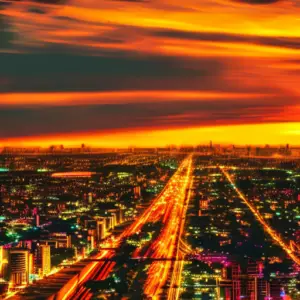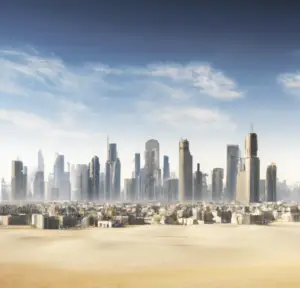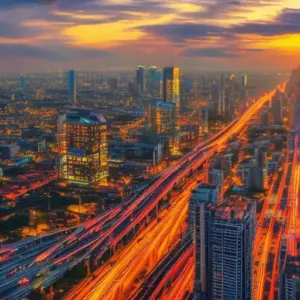Urbanization is a process that translates to an exodus of people from rural areas into cities, resulting in physical and social transformations.
This shift can be attributed to economic development, technological progression, migration trends, and government regulations.
The pros of urbanization encompass economic development, increased educational opportunities, improved convenience through access to essential services, higher standards of living, and efficient space utilization. The cons of urbanization involve stress on existing social services and infrastructure, environmental degradation, escalated levels of crime, prostitution, drug abuse, challenges related to street children, spread of diseases, and issues in governance. With effective management, the impacts of urbanization can be addressed to realize its sustainable potential.

A Historical Overview of Urbanization
From ancient times until today, the steady trend of urbanization has been spurred on by various forces – from politics to economics.
This growing process is characterized by increasing city population density or transforming rural land into built-up areas.
Urbanization has existed since ancient times, with the oldest examples in civilizations such as Mesopotamia and Egypt.
These cities served as epicenters of political power, economic prosperity, and cultural advancement.
As time passed, the rise of urban areas kept growing due to factors like trade expansion during the 19th-20th century that led to further industrial development and transportation growth.
The industrial revolution in Europe led to a massive influx of workers into the cities, transforming them from small settlements to sprawling metropolises.
This surge caused congested urban areas and slums where public health quickly deteriorated, leaving inhabitants in harsh conditions filled with poverty and despair.
Many countries experienced tremendous change during this period as they adapted to these new realities through social reforms, economic diversification, and political restructuring.
Urbanization continued to expand exponentially, leading to the conception of colossal public works projects and new industries.
The post-World War II period brought a surge in automobile use and suburbanization across Europe and the United States; these advancements further bolstered urban progression.
In the developing world, urbanization has taken an unconventional form due to a surge of migration from rural areas and natural population growth.
This development caused the rise of informal settlements and slums typically deprived of essential services, including water and sanitation.
Urbanization has undeniably increased in the last few decades and is estimated to reach two-thirds of the global population by 2050.
While it can bring economic and social advantages, overcrowding, poverty, and environmental destruction remain serious concerns that need addressing.
Ultimately, urbanization remains a significant influence in shaping our history while playing an essential role in future cities’ growth and prosperity.

Causes of Urbanization
Economic growth and development are the main forces behind urbanization, as cities provide more desirable job opportunities with higher salaries than rural zones.
Other influencing factors, such as political policies and resources, contribute to city expansion.
On top of that, social elements like a craving for upgraded living conditions and improved access to services can also be credited for urban growth.
Thanks to new technologies such as transportation and communication advancements, urbanization has been positively affected, making it more straightforward for people to reside and conduct business in cities.
Pros of Urbanization
- Increased job opportunities
- Improved infrastructure
- Access to better healthcare facilities
- Access to education
- Improved standard of living
- Access to a broader range of services
- Improved transportation
- Better access to technology
- Increased cultural diversity
- Increased economic growth
- Increased investment
- Better access to finance
- Increased safety and security
- Improved waste management
- Better living conditions
- Increased access to electricity and clean water
- Increased access to recreational facilities
- Better access to emergency services
- Increased social interaction
- Increased opportunities for entrepreneurship

Increased job opportunities
Urbanization offers many employment prospects due to the influx of businesses and industries that settle in urban areas.
This leads to increased job availability, which boosts the local economy overall.
Improved infrastructure
Urbanization not only strengthens infrastructure, like upgraded roads and more efficient transport systems and communication networks but also enhances individuals’ quality of life.
It is critical for businesses to thrive with improved accessibility and ease of operation.
Access to better healthcare facilities
By residing in urban areas, citizens benefit from superior medical treatments and facilities that can strengthen their health and prosperity.
Consequently, they can receive more advanced healthcare services than those in rural regions.
Access to education
Urban areas offer an immense array of educational opportunities, from primary schools to universities.
This provides residents with abundant access to education, which can significantly enhance their life prospects and job possibilities.
Improved standard of living
Urbanization can provide more excellent living standards, providing people with improved job prospects and access to education, healthcare, and other amenities.
This paves the way for residents to experience higher quality lives through increased means of opportunity.
Access to a broader range of services
Urbanization can bring many advantages to city dwellers, providing them with a more excellent selection of services and amenities.
From diverse shops and eateries to entertainment options and banking centers, the quality of life for those living in metropolitan areas is enhanced considerably as they gain access to these resources.
Improved transportation
Urbanization often significantly improves transportation systems, such as more extensive public transit links and new highways and roads.
This improved mobility makes it easier for people to travel back and forth, alleviating road congestion.
Additionally, more effective transport can help businesses reach their patrons better while streamlining operations simultaneously.
Better access to technology
Urban areas generally possess more advanced access to the internet and technology than their rural counterparts.
This can be seen through quicker, more dependable web connectivity and access to higher-level tech in sectors such as healthcare and schooling.
In addition, improved entry to modern technologies provides citizens with excellent living standards while enlarging their ability to partake in the digital world economy.
Increased cultural diversity
In cities, cultural diversity flourishes naturally.
Residents bring various backgrounds, heritages, and customs that create a vibrant sense of community and connectedness.
Diversity encourages an inclusive environment where all members feel appreciated and bring unique offerings, such as diverse cuisines and art forms from different cultures, to explore.
These experiences broaden our horizons, providing us insight into the lives of others while helping us build more meaningful relationships within our city’s boundaries—allowing for greater social cohesion in urban settings than ever before!
Increased economic growth
Urbanization has the potential to stimulate economic growth in a myriad of ways.
The commercial and industrial sectors are drawn to city centers due to unparalleled infrastructure, resources, and access to an expansive workforce.
This influx of capital generates jobs, leads businesses toward expansion initiatives, and aids general economic activity on a larger scale — all resulting in increased investment opportunities that ultimately translate into long-term prosperity for society.
Increased investment
Urbanization draws in investment from the public and private sectors, as entrepreneurs and people want to leverage the enhanced infrastructure and amenities in urban environments.
This extra capital can produce fresh employment opportunities, enhance existing facilities, and invigorate local enterprises – all of which contribute to broader economic growth and success.
Better access to finance
Urban locations are equipped with special access to fiscal facilities such as banks and other loan providers.
This enhanced access to finance can empower enterprises, individuals, and organizations by offering them loans plus additional forms of capital, which could promote the formation of job opportunities, foster development and catalyze investments.
Increased safety and security
Urban areas are far more capable of providing safety and security to their citizens than rural ones.
The range of protective measures they can offer, such as enhanced emergency services like police officers and firefighters or surveillance cameras and local watch groups, fosters a secure atmosphere for inhabitants while boosting their quality of life overall.
Improved waste management
Urbanization can help optimize waste management since cities typically have the tools and technology necessary to dispose of trash properly.
This can be beneficial in lowering pollution levels, safeguarding our environment, and keeping citizens healthy by avoiding hazardous substances.
Better living conditions
Urbanization can improve many citizens’ lifestyles due to better access to essential services such as clean water and electricity.
Additionally, multi-family housing options like apartments may be more available in urban areas than single-family homes, which helps make it simpler for people of all incomes to find suitable accommodation that fits their budget.
Ultimately, these improvements can work together to enhance the quality of life of those living in cities everywhere.
Increased access to electricity and clean water
Urbanization can profoundly improve citizens’ lives by offering them access to electricity and clean water.
This is because cities are typically equipped with a more advanced infrastructure for these services, allowing businesses in those areas to operate optimally.
Furthermore, this better access improves the quality of life and can stimulate economic growth through increased productivity rates.
Increased access to recreational facilities
Urban areas provide citizens with a vast array of recreational facilities and amenities, from public parks to sports complexes to cultural attractions.
These assets can noticeably raise the quality of life for city dwellers and be channels for socialization and civil engagement.
Better access to emergency services
Urban residents enjoy a much higher level of health and safety protection than those living in rural areas due to the improved access to emergency services, such as police, fire, and medical attention.
These resources’ availability assures city dwellers that their well-being is protected during an unexpected event.
Increased social interaction
Urban life can bring people of different cultures and backgrounds together, encouraging social interaction that creates a sense of community.
This natural connection promotes inclusivity and enhances the quality of life for all city dwellers.
Increased opportunities for entrepreneurship
The entrepreneurial culture of cities is alive and thriving, which brings a swell of start-ups and small businesses.
This can create countless job opportunities that fuel economic growth and allow individuals to pursue their dreams through entrepreneurship.

Cons of Urbanization
- Overcrowding and housing shortages
- Increased pollution
- Traffic congestion
- Increased crime rates
- The increased cost of living
- Loss of green spaces and natural habitats
- Strained public services and utilities
- Increased social inequality
- Soaring property prices
- Loss of traditional communities and cultural heritage
- Unaffordable housing
- Increased waste management problems
- Limited access to nature and outdoor space
- The decline in air quality
- Increased noise pollution
- The strain on public transportation
- Soaring real estate prices
- Increased urban sprawl and loss of farmland
- Increased stress and mental health problems
- Increased competition for jobs and resources

Overcrowding and housing shortages
Urbanization can cause a surge in population density and overcrowding, which unfortunately negatively impacts the mental health of those residing there.
Furthermore, it puts pressure on the housing supply leading to costly rental fees that make a living in cities unaffordable for many.
Moreover, high-density living deprives citizens of accessing green spaces and enjoying the personal privacy they deserve.
Increased pollution
As cities expand, industrial and commercial activities may also increase, often resulting in more significant air and water pollution.
Unfortunately, this can have a detrimental effect on the well-being of urban citizens and their environment.
Air contamination could be responsible for respiratory distress, cardiovascular issues, or other health hazards.
Likewise, water pollution has impacts, including ecosystem destruction and drinking water desecration.
Traffic congestion
As cities grow, more vehicles find their way onto the streets, resulting in a surge of traffic gridlock and longer-than-usual travel times.
This squanders precious time and resources, causes air pollution, and raises greenhouse gas emissions.
Moreover, it can also cause heightened stress levels while lowering residents’ quality of life in urban areas.
Increased crime rates
Urbanization can lead to a surge in criminal activity, as cities offer the perfect mix of people and wealth for illegal activities.
This rise in crime is devastating for those living in urban areas – ruining their quality of life and compromising security levels across the board.
The increased cost of living
Urbanization often leads to increased demand for goods and services, resulting in higher prices and an increased cost of living.
This can make it difficult for people to afford to live in urban areas, particularly those with lower incomes.
Additionally, the increased demand for real estate in urban areas can result in higher housing costs, making it difficult for people to find affordable housing.
Loss of green spaces and natural habitats
Urban growth frequently results in the depletion of precious green spaces and natural habitats as cities expand and devour land previously untouched.
This lack of vegetation can damage our environment, decreasing space for wildlife to thrive while also causing temperatures to rise and air quality to drop within urban areas.
Unluckily, it’s not just nature that suffers from this loss; people, too, feel its effects by having fewer outdoor recreational options available for them to take advantage of.
Strained public services and utilities
Urbanization can leave public services and utilities, like hospitals, schools, water supplies, and sewage systems, over-tasked and overrun.
As a result of the population growth outstripping these resources, the quality of service reduces while costs rise.
Trying to upgrade or expand infrastructure to accommodate extra people is an expensive challenge for many cities around the globe.
Increased social inequality
As cities grow, it can lead to a more significant disparity between the wealthy and those with fewer resources; this often leads to higher poverty rates in urban centers alongside an absence of access to vital services like healthcare, education, and more for low-income communities.
This widening social inequality causes homelessness levels in cities worldwide to rise drastically.
Soaring property prices
Urbanization has the potential to create a domino effect, beginning with skyrocketing property prices that make it difficult for people to acquire or rent their own homes.
Consequently, this can leave too many without shelter, endure housing insecurities, and even face homelessness due to a lack of affordable housing options.
Loss of traditional communities and cultural heritage
Urban growth can seriously affect social and cultural life, as it often destroys traditional communities and their unique heritage.
This heartbreaking loss erases precious historical memories and has damaging repercussions for urban areas’ identity, community cohesion, and sense of belonging among its citizens, who feel increasingly isolated due to displacement.
Unaffordable housing
An increased demand for housing in urban areas can lead to a scarcity of affordable dwellings, making it challenging – especially for those with lower paychecks – to locate accommodations.
This development may eventually result in an inflated population of people without a roof over their heads, inadequate access to housing services, and decreased ability to obtain healthcare or education.
Increased waste management problems
Urbanization can be a significant source of waste management problems, as the growing population and intensified industrial activities generate more rubbish.
This leads to higher levels of air, water, and soil contamination, severely affecting health and environmental well-being.
Limited access to nature and outdoor space
Urbanization can severely impact the health and well-being of city dwellers, as it leadwell-beingr green spaces and natural habitats, thus reducing access to nature.
This also decreases chances for physical activity since many outdoor recreational areas become unavailable.
Steps must be taken towards preserving these vital resources so that urban residents can continue enjoying their outdoor activities in an environment filled with fresh air and lush vegetation.
The decline in air quality
As urban areas become more densely populated, air pollution increases significantly, and air quality decreases.
This can have a devastating effect on residents’ health as well as damage to the environment at large.
Inhalation of polluted air can lead to severe respiratory diseases or cardiovascular issues and contribute to worldwide climate change.
Increased noise pollution
The growing population and amplified industrial activity associated with urbanization can cause high levels of noise pollution, which has severe implications for both human health and the environment.
This excessive sound produces higher stress levels and deteriorates the quality of life for its residents.
The strain on public transportation
Urbanization can heavily burden public transportation systems, exacerbating the need for more efficient and dependable solutions.
As population growth continues to rise along with urban mobility demands, traffic jams will increase significantly, commutes will become longer, and access to essential services like healthcare and education will diminish for people reliant on public transport.
Soaring real estate prices
With more and more people looking to purchase or rent homes in city centers, prices have skyrocketed, making it harder for many individuals to access affordable housing.
This has caused a surge in homelessness and renders families unable to secure stable housing.
Increased urban sprawl and loss of farmland
Urbanization can cause greater urban sprawl as cities absorb more undeveloped land.
Unfortunately, this can lead to diminished farmland and the disintegration of natural habitats, escalating greenhouse gas emissions and decreasing individuals’ access to food.
Increased stress and mental health problems
Urbanization can be detrimental to mental health and well-being, with the high population density, hurried lifestyle, and lack of access to nature taking an emotional toll on residents.
Anxiety, depression, and other psychological distress are expected outcomes of these circumstances, leading to a decreased quality of life.
Increased competition for jobs and resources
Urbanization can lead to a more competitive job market, and the demand for essential goods, services, healthcare, and education may rise faster than what is available.
This could potentially increase poverty levels and social inequality and make it even harder for those at the bottom of society’s ladder to access necessities.

Impacts of Urbanization
Urbanization has left an indelible mark on our cities’ environment, society, economy, and infrastructure.
Unfavorable consequences for nature include increased pollution levels, lost green areas, and decreased air and water quality.
Social issues like overcrowding and higher crime figures have become more prevalent due to rising urban populations and a weakening sense of community cohesion.
Economically there is both positive news – with cities driving economic growth resulting in new job opportunities- and negative implications, such as escalating living costs compounded by inequality issues further widening divides between social classes.
As cities become more populated, infrastructure, such as transportation and public services, become increasingly strained, causing traffic congestion and other issues.
Managing the Impacts of Urbanization
Urbanization carries with it a series of drastic effects, which necessitates the need for effective ways to manage them.
Sustainable urban planning is one such method and should be adopted at all levels.
minimizing waste production, preserving natural environments, and encouraging public transportation are essential components in this context.
Traffic congestion can also be minimized when appropriate infrastructure improvements are made – like ensuring an efficient public transport system – so we can effectively address rapid urbanization’s impacts.
Addressing and resolving social and economic inequities can yield a much fairer outcome for those living in our cities, which is why it’s essential for any successful urban management strategy.
The Future of Urbanization
The future of urbanization is unclear.
However, it will continue to be a significant factor in the transformation of our world.
Estimates for expected city growth are disputed, but most forecasts anticipate that most of its inhabitants will remain within cities.
We can expect significant changes in how streets and communities operate through technological breakthroughs such as artificial intelligence, IoT, and intelligent townships.
In addition, global phenomena like migrations into urban regions, environmental change, and expanding economies could drastically shape the trajectory of urban development far into the future.
Crafting an equitable, sustainable future for cities is essential, and governments have the power to make it happen.
By promoting development that considers environmental concerns as well as social needs, policymakers can work to mitigate any drawbacks of urbanization.
Final Thoughts
Urbanization is a complicated yet essential process that has drastically reshaped the world.
It’s of utmost importance for leaders, governments, and individuals to comprehend urbanization’s past, motivations, consequences, and what lies ahead.
Through our collective efforts, we can foster sustainable growth in cities and improve living conditions in urban areas around the globe.
Resources
https://en.wikipedia.org/wiki/Urbanization
https://ourworldindata.org/urbanization
https://education.nationalgeographic.org/resource/urbanization
https://www.epa.gov/caddis-vol2/urbanization-overview
https://publichealthreviews.biomedcentral.com/articles/10.1186/s40985-019-0116-0
